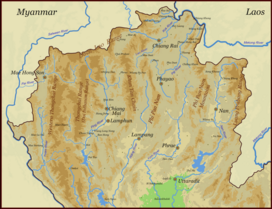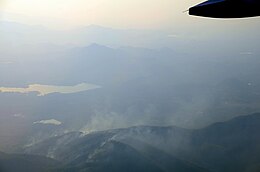Khun Tan Range
| Khun Tan Range | |
|---|---|
| ทิวเขาขุนตาน | |
Mae Lao District | |
| Highest point | |
| Peak | Doi Mae Tho |
| Elevation | 2,031 m (6,663 ft) |
| Coordinates | 19°05′00″N 99°20′30″E / 19.08333°N 99.34167°E |
| Dimensions | |
| Length | 260 km (160 mi) N/S |
| Width | 50 km (31 mi) E/W |
| Geography | |
 Map of the Thai highlands | |
| Country | Lamphun |
| Parent range | Phi Pan Nam Range |
| Geology | |
| Age of rock | Triassic |
| Type of rock | granite, phyllite, shale and limestone |





The Khun Tan Range (
The geological composition of the Khun Tan mountains is different from the neighboring Thanon Thong Chai Range in the west and the Daen Lao Range in the north. Precambrian rocks are absent in this mountain chain which is thus not part of the Shan Hills system.[3] The geology of the Khun Tan Range is homogeneous with the Phi Pan Nam Range further east[4] and some scholarly works designate the Khun Tan as the "Western Phi Pan Nam Range", including it as part of the Phi Pan Nam Mountain System.[5]
Geography
The Khun Tan Range begins south of the
Along with the westernmost range of the
History
Historically the Khun Tan Range was a formidable
The
There are certain
Thailand Route 118 between Chiang Mai and Chiang Rai cuts diagonally across the Khun Tan Range from SW to NE about 30 km northeast of Chiang Mai town.
Ecology
The lower altitudes are covered with dry
Extensive
Although the large trees are not too badly affected, the periodic fires negatively affect the wildlife of vast areas of the mountain chain. These yearly wildfires are the main cause of the intense
Wildlife
Many species of mammals are assumed to have disappeared in the range for lack of recent sightings, such as the
.Among the birds, the ashy drongo, scarlet minivet, grey-headed canary-flycatcher, white-crowned forktail, brown fish owl, crested serpent eagle, shikra, velvet-fronted nuthatch, blue-throated barbet, coppersmith barbet, blue-winged leafbird, brown-cheeked fulvetta and red junglefowl deserve mention. The Khun Tan mountains also act as a natural barrier for species west and east of the range, such as the
Reptiles in the range include the
Protected areas
The
- Doi Khun Tan National Park
- Chae Son National Park
- Khun Chae National Park
- Si Lanna National Park
- Doi Wiang Pha National Park
Tourism
Tourist attractions of the Khun Tan Range include caves, waterfalls and natural hot springs. The
See also
References
- ^ ผศ.นงรัตน์ พยัคฆันตร. ภูมิศาสตร์การท่องเที่ยวไทย. มหาวิทยาลัยราชภัฏสวนดุสิต พ.ศ. 2528 (ปรับปรุง พ.ศ. 2549)
- ^ Northern Thailand Archived 2012-01-28 at the Wayback Machine
- ^ "Geology of Thailand - Ministry of Natural Resources and Environment, Bangkok". Archived from the original on 2017-12-01. Retrieved 2012-01-20.
- ^ ทิวเขาผีปันน้ำ Archived 2012-03-10 at the Wayback Machine (in Thai)
- ^ "Sarasawadee Ongsakul, The History of Lanna". Archived from the original on 2008-12-07. Retrieved 2012-02-27.
- ^ Khun Chae National Park Archived 2010-09-22 at the Wayback Machine
- ^ Heritage Thailand, Geography 4 Archived 2011-10-07 at the Wayback Machine
- ^ Snow in Thailand
- ^ "The White Bridge: Celebrating the 80th birthday of His Majesty King Bhumibol". Archived from the original on 2015-10-22. Retrieved 2012-01-20.
- ^ "The Beginning of the Railway in Thailand". Archived from the original on 2012-09-25. Retrieved 2012-01-21.
- ^ Brendan Whyte, The Railway Atlas of Thailand, Laos and Cambodia, White Lotus, Bangkok, 2010
- ^ อุโมงค์รถไฟถ้ำขุนตาน จากเว็บไซต์สำนักงานสรรพากรพื้นที่ลำพูน] Thai: ภาษาไทย
- ^ The Politics of Ethnic Tourism in Northern Thailand
- ^ Bangkok Post - PM misses the boat again on northern haze
- ^ Mushroom Research Center Archived 2012-01-27 at the Wayback Machine
- ^ National Forest Policy Review- Thailand
- ^ "Underlying Causes of Deforestation". UN Secretary-General’s Report. Archived from the original on 2001-04-11.
- ^ Aseanbiodiversity - The Occurrence of the Pied Stonechat in Eastern and SE Thailand Archived 2016-03-04 at the Wayback Machine
- ^ Thai Elephant Conservation Center (TECC)
- ^ Joshua Morris & Khaetthaleeya Uppakham, A Guide to Rock Climbing in Northern Thailand. Nopburee Press Co., Ltd. Chiang Mai, 2004.
External links
- Google Books, The Physical Geography of Southeast Asia
- Chiang Mai’s Best Kept Secret - Khun Tan National Park
- Chae Sawn (Chae Son) National Park
- Mae Ta Krai National Park
- Chiang Mai Rock Climbing Adventures
- Khun Chae National Park
- Railway Trip
- Shrine of the Guardian of the Mountains (ศาลเจ้าพ่อขุนตาน)
- Rapid 102 by ALS - 4119 On Khun Tan Mountain Range 2
